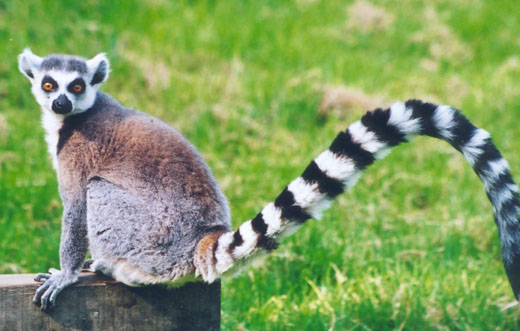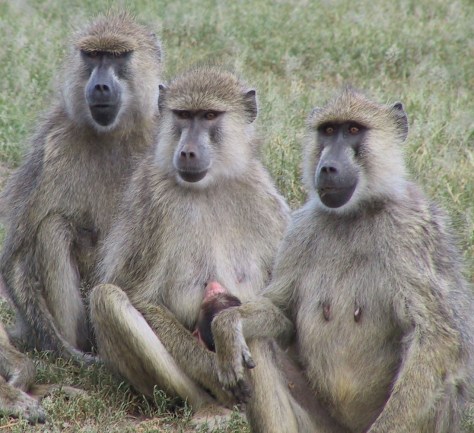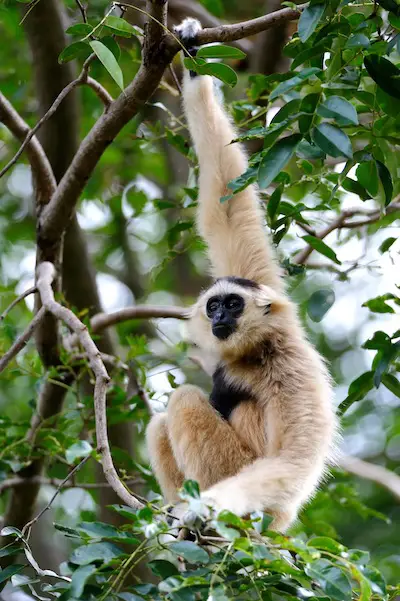Lemur (Prosimians/Strepsirhini)
This particular primate lives “exclusively on the island of Madagascar and the nearby Comoro Islands”
as stated by the website anthro.palomar.edu. Madagascar has a tropical
climate on the coast, and arid in the south.
These primates body size varies within lemurs, some species are
slightly larger than mice and others are up to four feet long. They have long bushy tails that are
used for balancing as they jump from branch to branch. However they cannot grip
with their tails, they use their hands and feet to move through the
trees. Most lemurs rarely go on the
ground but ring tail lemurs spend majority of their time on the ground. They
like to feed at night so they can avoid larger predators, and are mostly
nocturnal. They also have a well-developed sense of smell and often mark
territorial limits with scent.
When it comes to sexual
dimorphism, Lemurs are different from other primates because the females are usually
bigger than the males. Also in certain species of lemurs you can determine the
sex by their fur color.
A larger lemur needs less energy than a smaller lemur would. Their
diets prove this is true because larger lemurs are herbivorous while the small
dwarf and mouse lemurs have an insectivorous diet. Therefore their body size is
adaption to their environment.

Spider Monkey (new world monkey/ Platyrrhini)
New World monkeys are limited
to tropical forest environments of southern Mexico, Central, and South America
The New World Monkeys vary in sizes, which range from 18 to 25 inches
and weigh around 10- 19 pounds. Due to the lack of dimorphism, males and
females are relatively the same size. However the males can be slightly bigger
than females. Due to the fact that this
species are all small and they don’t need to be bigger to attract a female or
fend off any other males they do not differ in size too much.


Baboon (Old World
Monkey/Cercopithecidae)
Like the chimpanzee, the baboon is an African species. Baboons generally
prefer savanna and other semi-arid habitats, though a few live in tropical
forests according to national geographic.
On average baboons weigh from 33 to 82 pounds. Baboon bodies are 20 to
40 inches long, not including substantial tails of varying lengths. They do not
have gripping tails like many other old world monkeys, but they can and do
climb trees. The website http://anthro.palomar.edu states “cercopithecines are usually very sexually
dimorphic…Adult males are often twice as large as females and much more
aggressive. Male savanna baboons grow up to 80 pounds and have powerful
jaws with long canine teeth.”
These
male traits are influenced by the environment because they are effective
weapons in defense against predators and competition with other males for mates.
The baboon on the left is a female, and the baboon on the right is a male.

Gibbon (lesser ape/ Hylobatidae)
Along with orangutans, gibbons
live in the dense forests of south Asia.
According to the website anthro.palomar.edu,
gibbons are the smallest and the most arboreal species. Most gibbons are about
3 feet tall while standing upright. They weigh around 12-20 pounds, however the
males in the biggest gibbon species can weigh up to 30 pounds. The anthro.palomar.edu
website also states “Gibbons have little sexual dimorphism in body size, with
the exception of siamangs. However, the sexual dimorphism of siamangs is
slight compared to that of the great apes.”
Their body size has been influenced
by the environment because they live in the forests of Asia. They move around
from tree to tree using suspensory
climbing. If they were bigger or weighed more it not only would be difficult
for the species, but a lot of the tree branches in the forest would not be
capable of carrying all of that weight.


Chimpanzee
(great ape- hominidae)
Along
with gorillas and bonobos,
chimpanzees are exclusively African apes. Chimpanzees can be found in the rain
forests and wet savannas of Africa.
Male chimps grow to 5½ feet tall
and average about 100 pounds with 6 foot arm spans. The female chimpanzees are
usually only around 82 pounds and are less muscular. This species is
comfortable with walking on all fours, or swinging from trees. The difference
between a male and a female chimp is their size. The males are bigger and the
females are smaller as stated before. Males need to be bigger and stronger to
be dominant over other males.
The male chimps size is
important because their size attracts female chimps, and is an advantage when
fighting other males for dominancy and passing on their genes.


Hey Angelica,
ReplyDeleteI like the pictures you chose to show your primates, as for the information was very informative.I didn't know that lemurs used their busy tails to balance themselves whiles jumping from branch to branch Over all great job.
You did an excellent job, I learned a few new facts form reading your post. I liked how your explanations were clear and how your pictures reiterated your point.
ReplyDeleteHi Angelica,
ReplyDeleteYour blog was very descriptive and I liked how certain points you discussed were also shown on the pictures you posted. For example you mentioned how Lemurs were sometimes slightly bigger than a mouse and you followed it by showing someone holding a Lemur that looked almost the same size if not smaller of the hand of the person holding it.
While I was reading your description of the Chimpanzee I started thinking how powerful Chimpanzees are and yet they are literally almost my size. I've read stories on how attacks of chimps are deadly and a couple of years ago one attacked its owner and left her disfigured. They are full of strength, their size might fool anyone thinking they can go against an animal that size.
Good Post.
Jeannette Lara
Good descriptions and you also made some very good connections between body size/sexual dimorphism and the environment. Yes, smaller body sizes tend to be associated with more arboreal environments with terrestrial primates being larger, not only because they can be larger but also because they need to be to defend against predation.
ReplyDeleteGreat job pulling in the issue of body size and energy needs. Well done.
With regard to sexual dimorphism, you've highlighted that larger males are associated with both defense and reproduction with multiple females (and fighting off other males). Does this help you explain why gibbons tend to not show sexual dimorphism? Why do you think lemur females tend to be bigger than males?
What about other types of dimorphism such as longer canines and coloration (you mention this in lemurs. What about gibbons?)?
Summary? I would have liked to have seen how you pulled all of this information together.
Good images.